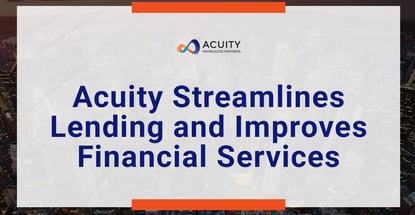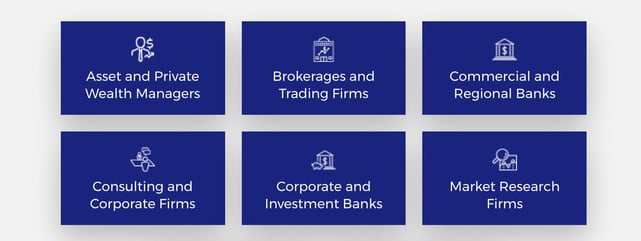
Our experts and industry insiders blog the latest news, studies and current events from inside the credit card industry. Our articles follow strict editorial guidelines.
In a Nutshell: Acuity Knowledge Partners aims to help banks and other financial institutions revise internal workflows to improve front-office efficiency. Its technology and finance expertise allows institutions to pinpoint their problems and develop effective solutions. As conditions during the COVID-19 pandemic led to more out-of-office work and automation in the banking industry, Acuity Knowledge Partners promoted growth by ushering banks away from cumbersome legacy systems and workflows.
During the COVID-19 pandemic, a major West Coast bank was focused heavily on Paycheck Protection Program (PPP) loans. But the institution also saw growth opportunities arise at the same time. Luckily, the bank worked with Acuity Knowledge Partners, which helped it implement changes and achieve its goals.
“They decided for rapid staff augmentation in a short space of time,” said Damian Burleigh, Chief Revenue and Marketing Officer at Acuity Knowledge Partners. “They got to learn the totality of the capability and then were quickly thinking, ‘We don’t want to lose that, we’ll extend it.’ That just opened their eyes to what else you can do if you’ve got an open mind.”
Acuity Knowledge Partners helps organizations augment their front office and, to a certain extent, middle-office teams to provide superior service. It accomplishes that by bringing in domain experts and bespoke technology to solve problems for client institutions.

“When an executive says, ‘We’re going to go here,’ a whole load of people start worrying about it,” Damian said. “They’ve still got to keep the rest of the machine running. And they don’t want to have the view that it can’t be done because it’s always been done a certain way. That’s where we come in.”
The changes may include everything from hiring practices to updating legacy infrastructure. Acuity Knowledge Partners makes those transitions seamless so institutions can serve their customers better and focus on growth.
Overcoming Institutional Roadblocks to Innovation
One of the most significant problems financial organizations face is repetition. Industry jobs often involve tedious tasks, so workers would fill specific roles for a year or two and then move on. That led to high churn and the need to hire and train new employees continuously. And that may be even more difficult than it appears at first glance.
“The hiring ratio for those roles has become more and more difficult,” Damian said. “It isn’t always as attractive as it might look from the outside.”
Addressing those issues is often more complex than it seems. Changing a system from within is a process that requires a long tenure and a high rank within the institution. According to Damian, patience isn’t always there.

This problem stems from institutional inertia. Internal change has to tackle legacy infrastructure and its established workflows. As beneficial as change and improvement may be, it’s also internally disruptive. Beyond new processes, staff members need training. Often, it’s easier to keep doing things the way they’ve always been done — especially in the short term.
“The bottom line is, how do we make sure our staffing pyramids create the highest client value while managing attrition risk that would occur whether you’re in the bank or with us?” Damian said. “And we ensure that we don’t expose our clients to any other issues with that kind of model.”
Virtual Captive Outsourcing Reduces Risk at All Scales
Acuity works in capital markets, financial services, and areas that focus on banking, asset management, and private equity. Credit is at the heart of Acuity’s current work, from direct lending and investment research perspectives.
“We’re heavy in credit and risk in terms of our underwriting, and we also have a compliance franchise as well,” Damian said. “In the investment banking space, we are probably with most of the top 10 institutions in some shape or form.”
Acuity is also involved in corporate banks and small community banks. In all cases, Acuity adds value to front office operations no matter the institution’s size. It takes a consultative approach with a team dedicated to the augmentation of each particular institution.
“We have various models, but the prevalent model is one organization with dedicated security,” Damian said. “We only work with them on their IDs, and that data doesn’t leave their network. It’s all secure and done.”
Acuity offers a range of improvements from load balancing, time zone management, and P&L management under that virtual captive model. Acuity guides clients through all the necessary changes.
“Frankly, not every job has to be in every costly location, and that’s not necessarily how some organizations were built and still struggle with that change,” Damian said. “So we’re helping show them that they can, as long as they have the right partner.”
Real-Time Service Assessments Guide Quality Outcomes
A significant factor in Acuity’s success is its real-time assessment built into the process. Acuity receives feedback from all levels of an organization through built-in scorecards, which allows for rapid adjustments and iterative development.
“For instance, if we were delivering a batch of mortgage documentation on lending information, it would be assessed in real time by that organization. That would give us a score on what their view of this was,” Damian said.

“So you not only have it on the individual projects but actually as a collective.” Damian cited one instance of working with a US franchise. It wasn’t until the Acuity team started its process that it realized how big a problem the organization faced from failed applications and the bureaucratic workload of reading and rechecking them.
“It was easy to make positive headway and come in and take the headaches away,” Damian said. “If you have to explain to a developer, ‘We need financial services,’ it’s hard to get someone with financial services domain expertise. Whereas we have that DNA, whether it’s on our tech side or the domain experts side.”
That dual expertise allows Acuity to work without requiring the client to explain their needs from the ground up. The ability to immediately connect and understand the necessary renovations enables Acuity to quickly assess the problem, devise solutions, implement them, and bring the organization up to speed.
The Pandemic Highlighted a Need for Banking Efficiency and Competition
During the COVID-19 pandemic, remote work became more common. As individuals and teams work out of home offices, more banks are coming around to Acuity’s model.
“When you try to transform, the top of the house normally knows where it wants to get to. We see more middle management and end-user support once the benefits of our solutions are felt,” Damian said.
From Damian’s perspective, the banking industry has weathered the pandemic relatively unscathed compared to other sectors. And Acuity is bullish on where the financial system is going and how the banking market will expand.
Damian said he expects increased competition, which means banks will need to be more efficient, and automation is vital for that job. Institutions need to compete on pricing and service, and technology can help them economize both.
“People are no longer prepared to deal with chunky KYC (know your customer) processes, or your application gets lost in the post,” Damian said. “That’s the experience I’ve had personally in mortgage applications, but it’s all the way through, whether it’s a loan, a credit card, or it’s an SME underwriting for small or large complex credit. It’s the same problem, and I think it’s how we mesh that risk part of an organization with the business origination, the loan servicing, and the KYC.”

![12 Credit Cards with the Best Customer Service ([updated_month_year]) 12 Credit Cards with the Best Customer Service ([updated_month_year])](https://www.cardrates.com/images/uploads/2020/01/Credit-Cards-with-the-Best-Customer-Service.jpg?width=158&height=120&fit=crop)
![3 Best Credit Card Loans for Bad Credit ([updated_month_year]) 3 Best Credit Card Loans for Bad Credit ([updated_month_year])](https://www.cardrates.com/images/uploads/2018/03/loans.png?width=158&height=120&fit=crop)
![9 Loans & Credit Cards: 450 to 500 Credit Score ([updated_month_year]) 9 Loans & Credit Cards: 450 to 500 Credit Score ([updated_month_year])](https://www.cardrates.com/images/uploads/2018/06/450500.png?width=158&height=120&fit=crop)
![9 Loans & Credit Cards: 550 to 600 Credit Score ([updated_month_year]) 9 Loans & Credit Cards: 550 to 600 Credit Score ([updated_month_year])](https://www.cardrates.com/images/uploads/2018/07/550-to-600-Credit-Scores.jpg?width=158&height=120&fit=crop)
![7 Best Credit Cards & Loans: 800-850 Credit Score ([updated_month_year]) 7 Best Credit Cards & Loans: 800-850 Credit Score ([updated_month_year])](https://www.cardrates.com/images/uploads/2018/11/850.png?width=158&height=120&fit=crop)
![5+ Instant Approval Auto Loans For Bad Credit ([updated_month_year]) 5+ Instant Approval Auto Loans For Bad Credit ([updated_month_year])](https://www.cardrates.com/images/uploads/2021/05/Instant-Approval-Auto-Loans-For-Bad-Credit--1.jpg?width=158&height=120&fit=crop)
![7 Best Payday Loans For Bad Credit ([updated_month_year]) 7 Best Payday Loans For Bad Credit ([updated_month_year])](https://www.cardrates.com/images/uploads/2021/05/Best-Payday-Loans-For-Bad-Credit.jpg?width=158&height=120&fit=crop)